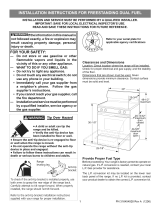
2. ELECTRICAL CONNECTION REQUIREMENTS - This
appliance must be properly installed and grounded by a qualied
technician in accordance with the National Electrical Code
ANSI/NFPA No. 70 -- latest edition -- and Local Electrical Code
requirements.
This appliance may be connected by means of "permanent
wiring" or power supply cord kit."
When installing permanent wiring, do not leave excess wire
in range compartment. Excess wire in the range compartment
may not allow the rear access cover to be replaced properly
and could create a potential electrical hazard if wires become
pinched. Connect only as instructed under "Permanent Wire
Connections" in Step 4c. When using exible conduit or range
cable use ex connector or range cable strain relief (Fig. 11).
(31.75mm)
Fig. 4
Fig. 5
Fig. 6
Fig. 7
Mobile home installations, new branch circuit installations
(1996NEC) or areas where local codes do not permit grounding
through neutral require a four (4) conductor power supply cord kit
rated at 125/250 volts minimum and marked for use with ranges.
See range connection opening size chart (Figs. 9 & 10) for cord
kit ampere rating information. Terminals on end of wires must be
either closed loop or open-end spade lugs with upturned ends.
2
INSTALLATION INSTRUCTIONS FOR FREESTANDING ELECTRIC RANGE
BEFORE STARTING - Tools You Will Need
For leveling legs and Anti-Tip Bracket:
• Adjustable wrench or channel lock pliers
• 5/16" Nutdriver or Flat Head Screwdriver
• Electric Drill & 1/8" Diameter Drill Bit
(Masonry Drill Bit if installing in concrete)
For electrical supply connection:
• 1/4" & 3/8" Socket driver or Nutdriver
Additional Materials You Will Need:
• Power Supply Cord or
• Copper Electrical Wiring & Metal Conduit
(for hard wiring)
NORMAL INSTALLATION STEPS
1. ANTI-TIP BRACKET INSTALLATION INSTRUCTIONS
- IMPORTANT SAFETY WARNING
To reduce the risk of tipping of the range, the range must be
secured to the oor by properly installed Anti-Tip Bracket and
screws packed with the range. Failure to install the anti-tip
bracket will allow the range to tip over if excessive weight is
placed on an open door or if a child climbs upon it. Serious injury
might result from spilled hot liquids or from the range itself.
If range is ever moved to a different location, the Anti-Tip Bracket
must also be moved and installed with the range.
Instructions are provided for installation in wood or cement
fastened to either the oor or wall. When installed to the wall,
make sure that screws completely penetrate dry wall and are
secured in wood or metal. When fastening to the oor or wall, be
sure that screws do not penetrate electrical wiring or plumbing.
1a. Locate the Bracket using the Template - (Bracket
may be located on either the left or right side of the range. Use
the information below to locate the bracket if template is not
available).
Mark the oor or wall where left
or right side of the range will
be located. If rear of range is
against the wall or no further
than 1-1/4" from wall when
installed, you may use the
wall or oor mount method. If
molding is installed and does
not allow
the bracket to t ush against the wall, remove molding or mount
bracket to the oor. For wall mount, locate the bracket by placing
the back edge of the template against the rear wall and the side
edge of template on the mark made referencing the side of the
range (See Fig. 4). Place bracket on top of template and mark
location of the screw holes in wall. If rear of range is further than
1-1/4" from the wall when installed, attach bracket to the oor.
For oor mount, locate the bracket by placing back edge of the
template where the rear of the range will be located. Mark the
location of the screw holes, shown in template.
1b. Drill Pilot Holes & Fasten Bracket - Drill a 1/8" pilot
hole where screws are to be located. If bracket is to be mounted
to the wall, drill pilot hole at an approximate 20° downward angle
(See Fig. 5).
If bracket is to be mounted to masonry or ceramic oors, drill a
3/16" pilot hole 1-3/4" deep. The screws provided may be used
in wood or concrete material. Use a 5/16" nut-driver or at head
screwdriver to secure the bracket in place (See Fig. 6).
1c. Level and Position Range - Level range by adjusting the
(4) leveling legs with a wrench. Note: A minimum clearance of
1/8" is required between the bottom of the range and the leveling
leg to allow room for the bracket. Use a spirit level to check your
adjustments. Slide range back into position (See Fig. 7). Visually
check that rear leveling leg is inserted into and fully secured by
the Anti-Tip Bracket by removing lower panel or storage drawer.
For models with a Warmer Drawer or broiler compartment, grasp
the top rear edge of the range and carefully attempt to tilt it
forward.
2a. Models with factory connected power supply cord.
NOTE: Some models may have a factory installed
three (3) conductor power supply cord.




